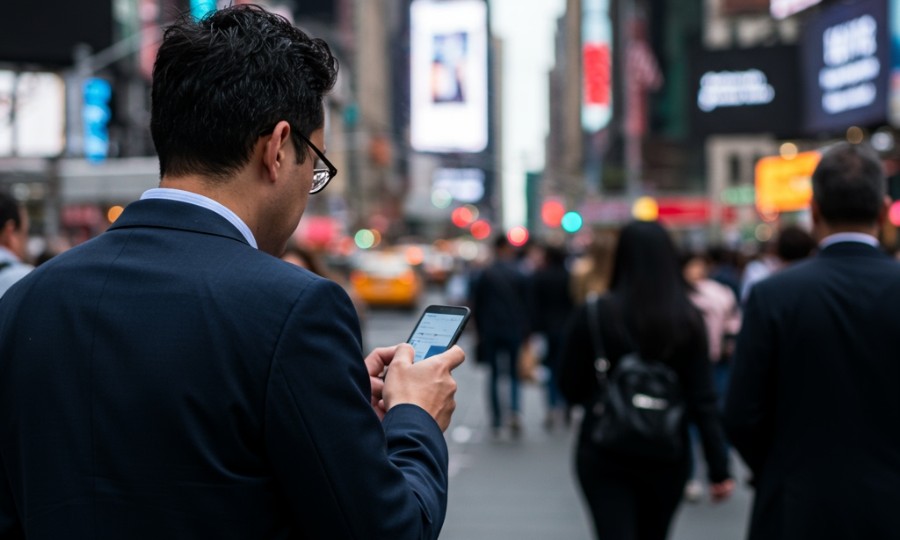
You’re rushing down a crowded New York City street, maybe dodging a hot dog stand, an aggressive taxi, or a street performer. Your phone buzzes, and instinctively, your eyes drop. Just for a second. But that second? In a city that never stops, it’s enough to change everything. We often talk about the dangers of distracted driving, and rightfully so. It’s a critical issue that contributes to countless accidents on our roads. But what about the person on foot?
Here’s the thing: while drivers get most of the attention for their digital diversions, there’s a quieter, yet equally perilous, epidemic unfolding on our sidewalks: distracted walking. In a city like New York, where millions navigate bustling streets daily, a moment’s inattention can have serious consequences. We’re not just talking about bumping into someone or missing your stop; we’re talking about a significant contributor to pedestrian accidents, injuries, and even fatalities. It’s a hidden danger that’s becoming increasingly visible, and it’s time we talked about it openly and honestly.
The Alarming Rise of Pedestrian Incidents in NYC
New York City is a marvel of pedestrian activity, but that vibrant energy comes with its own set of risks. The numbers, frankly, are a bit sobering. According to reports from the NYC Department of Transportation (DOT) and initiatives like Vision Zero, pedestrian fatalities and injuries remain a serious concern. While Vision Zero has made commendable strides in reducing traffic-related deaths, pedestrian safety, particularly concerning distracted behavior, continues to be a persistent challenge. For instance, the DOT’s ‘Annual Traffic Report’ often highlights that a significant percentage of severe pedestrian injuries and fatalities occur at intersections, precisely where a momentary lapse in attention — from either a driver or a pedestrian — can be catastrophic. It’s not just the big, dramatic collisions; it’s also the near-misses, the trips, and the falls that could have been easily avoided if only our attention hadn’t been elsewhere.
What Exactly is “Distracted Walking”?
You might wonder, ‘What even counts as distracted walking?’ It’s more than just texting. Generally speaking, it’s any activity that diverts a pedestrian’s attention from their surroundings, their path, or traffic conditions. Of course, the most common culprit we see these days is the smartphone. People are engrossed in emails, social media feeds, or streaming videos, completely oblivious to the world around them. But it’s not just screens. It could be listening to music at an excessively high volume, deep in conversation with a friend, or even navigating a complex map on a device. Anything that pulls your focus away from the immediate environment where you’re moving – especially in a dynamic, unpredictable place like NYC – falls under this umbrella. We’re talking about a fundamental shift in situational awareness, and it’s something we’re all guilty of doing at some point, aren’t we?
The Legal Landscape: Are There Laws Against This?
This is where it gets a little nuanced. Unlike distracted driving, which is clearly defined and prohibited by New York State law (think cell phone use while driving), there isn’t a specific statewide ‘distracted walking’ law. You won’t get a ticket just for walking while texting, at least not directly for that action. However, that doesn’t mean there are no legal implications. When an accident occurs, say a pedestrian walks into traffic and is struck by a vehicle, the legal concept of ‘comparative negligence’ often comes into play. New York follows a pure comparative negligence rule (CPLR § 1411). This means that if you, as a pedestrian, are found to be partially at fault for an accident – perhaps because you were distracted and not paying attention – your ability to recover damages from a negligent driver could be reduced by your percentage of fault. For example, if a jury determines you were 30% at fault for stepping into traffic while looking at your phone, and a driver was 70% at fault for speeding, your compensation would be reduced by 30%. It’s a crucial point, because while the primary goal is safety, understanding the legal ramifications can sometimes be the wake-up call we need.
Real-World Consequences: Beyond a Bumped Shoulder
Let’s get real about what this looks like on the ground. It’s not always just a minor stumble. Consider a scenario: a tourist, navigating Midtown Manhattan near Times Square, is deeply engrossed in their phone, trying to find directions. They step off the curb against the light, completely missing the ‘Don’t Walk’ signal and the yellow taxi making a legal turn. The result? A fender-bender for the cab, but a broken ankle and a concussion for the pedestrian. That’s a week in the hospital, months of physical therapy, and a hefty medical bill.
Or think about this: a local resident, walking home in Brooklyn, scrolling through TikTok, doesn’t see the uneven sidewalk slab or the discarded construction debris. They trip, fall awkwardly, and break a wrist. A simple oversight, a momentary distraction, has now led to a painful injury, lost work days, and a significant disruption to their life. Can a text message truly be worth a trip to the emergency room, or worse? These aren’t hypothetical; they’re daily occurrences in a city as dense and dynamic as ours. We’re seeing more reports of serious injuries, from head trauma to broken bones, directly linked to pedestrians failing to observe their surroundings.
Taking Back Our Streets: Practical Solutions for Pedestrians
So, what’s the solution then? It’s easy to feel frustrated by the constant pull of our devices, but we’re not powerless. Reclaiming our awareness on the streets of NYC starts with simple, yet impactful, changes in habit. First, let’s make a conscious effort to ‘look up.’ When you’re crossing a street, waiting for a light, or navigating a crowded sidewalk, your phone can wait. That email, that text, that social media update – it’s rarely as urgent as your personal safety. Second, be predictable. Walk defensively, just as you’d drive defensively. Make eye contact with drivers, even if you have the right of way. Assume they might not see you. Third, if you absolutely must use your phone, step off to the side, away from the flow of traffic and other pedestrians. Find a safe spot where you won’t be a hazard to yourself or others. It sounds basic, I know, but sometimes the most effective solutions are the simplest. We’re talking about building a new ‘street smart’ habit for the digital age.
Technology’s Role: Friend or Foe?
It’s a bit ironic, isn’t it? The very technology that often distracts us also offers potential solutions. Many newer smartphones now include features like ‘Heads-Up’ or ‘Screen Time’ reports that can alert you to your usage while walking, or even encourage you to look up. Apple’s iOS has a ‘Walking Steadiness’ feature which, while primarily for fall detection, subtly reminds you of your gait, perhaps making you more aware of your posture and surroundings. While these are helpful tools, they’re not a substitute for personal responsibility. The truth is, the fundamental choice rests with each of us. We have to decide if the momentary gratification of a notification is worth the potential risk to our safety and the safety of those around us. It’s about finding that balance, where technology serves us, rather than dominates our attention, especially when we’re out and about in a bustling environment like New York.
Navigating New York City is an art form, a dance between millions of people, vehicles, and the constant hum of life. Distracted walking isn’t just a minor annoyance; it’s a genuine public safety issue that demands our attention. We’re all part of the solution. By committing to being more present, more aware, and more responsible for our actions on foot, we can significantly reduce the risks for ourselves and for everyone else sharing our incredible city. So, the next time your phone buzzes on the street, take a moment. Look up. Take in the city. Your safety, and the safety of others, truly depends on it. Let’s make our streets safer, one conscious step at a time.
Free Case Consultation
Injured in an accident? Contact Rosenberg, Minc, Falkoff & Wolff for a free and confidential case review with an experienced NYC personal injury attorney.


